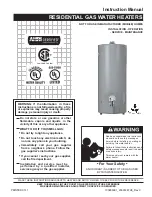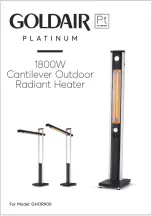
13
MIXING VALVES
Water temperature over 125°F (52°C)
can cause severe burns instantly
resulting in severe injury or death.
Children, the elderly and the physically
or mentally disabled are at highest risk
for scald injury.
Feel water before bathing or showering.
Temperature limiting devices such as
mixing valves must be installed when
required by codes and to ensure safe
temperatures at fixtures.
Water heated to a temperature which will satisfy clothes
washing, dish washing, and other sanitizing needs can
scald and cause permanent injury upon contact. Short
repeated heating cycles caused by small hot water uses
can cause temperatures at the point of use to exceed the
water heater’s temperature setting by up to 20°F (11°C).
Some people are more likely to be permanently injured
by hot water than others. These include the elderly,
children, the infirm and the physically/mentally disabled.
shows the approximate time-to-burn relationship
for normal adult skin. If anyone using hot water provided
by the water heater being installed fits into one of these
groups or if there is a local code or state law requiring a
certain water temperature at the point of use, then special
precautions must be taken.
In addition to using the lowest possible temperature
setting that satisfies demand of the application, a mixing
valve should be installed at the water heater or at hot
water taps to further reduce system water temperature.
See
Mixing valves are available at plumbing supply stores.
Consult a Qualified Installer or Service Agency. Follow
mixing valve manufacturer’s instructions for installation of
the valves.
TABLE 1. APPROXIMATE TIME-TO-BURN
Water
Temperature °F
Time for
1st Degree Burn
(Less Severe Burns)
Time for Permanent Burns
2nd & 3rd Degree
(Most Severe Burns)
110
(normal shower temp.)
116
(pain threshold)
116
35 minutes
45 minutes
122
1 minute
5 minutes
131
5 seconds
25 seconds
140
2 seconds
5 seconds
149
1 second
2 seconds
154
instantaneous
1 second
(U.S. Government Memorandum, C.P.S.C., Peter L. Armstrong, Sept. 15,1978)
WATER PIPING
WATER (POTABLE) HEATING AND SPACE HEATING
This water heater shall not be connected to any heating
systems or component(s) used with a non-potable water
heating appliance.
All piping components connected to this unit for space
heating applications shall be suitable for use with potable
water. Toxic chemicals, such as those used for boiler
treatment shall not be introduced into this system.
When the system requires water for space heating at
temperatures higher than required for domestic water
purposes, a mixing valve must be installed. See
(page 7) for the suggested piping arrangement.
These water heaters cannot be used in space heating
applications only.
CLOSED WATER SYSTEMS
Water supply systems may, because of code
requirements or such conditions as high line pressure,
among others, have installed devices such as pressure
reducing valves, check valves, and back flow preventers.
Devices such as these cause the water system to be a
closed system.
THERMAL EXPANSION
As water is heated, it expands (thermal expansion). In
a closed system the volume of water will grow when it
is heated. As the volume of water grows there will be a
corresponding increase in water pressure due to thermal
expansion. Thermal expansion can cause premature tank
failure (leakage). This type of failure is not covered under
the limited warranty. Thermal expansion can also cause
intermittent temperature-pressure relief valve operation:
water discharged from the valve due to excessive
pressure build up. This condition is not covered under the
limited warranty. The temperature-pressure relief valve is
not intended for the constant relief of thermal expansion.
A properly sized thermal expansion tank must be installed
on all closed systems to control the harmful effects of
thermal expansion. Contact a local plumbing service
technician to have a thermal expansion tank installed.
Содержание LTL07575
Страница 37: ...37 NOTES ...
Страница 38: ...38 ...














































